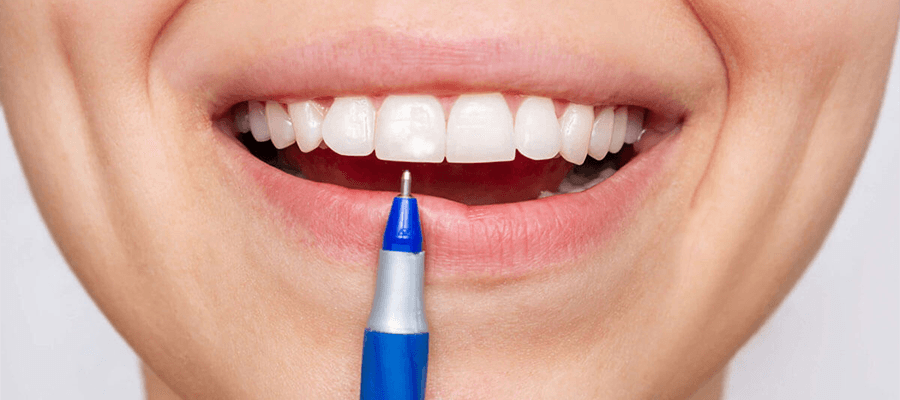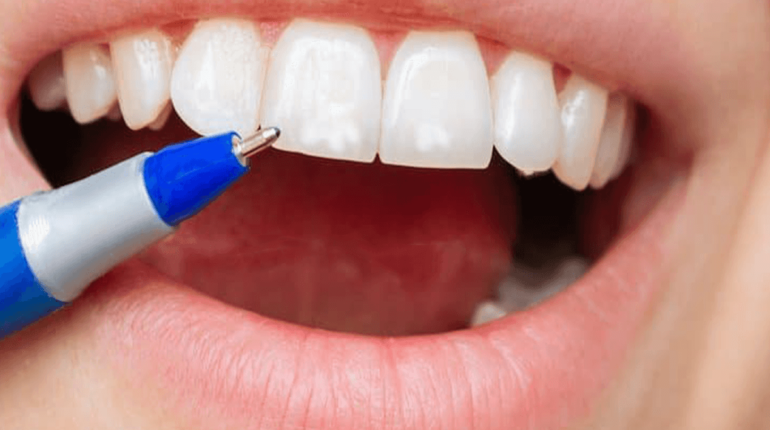Your teeth are like superheroes, and the white spots are the villains trying to mess up their perfect record. But fear not, because we’re about to unleash the ultimate arsenal against these sneaky foes.
How to get rid of white spots after teeth whitening? To remove post-whitening white spots, consider enamel microabrasion or dental veneers for a cosmetic fix. Stay hydrated, use fluoride toothpaste, and maintain good oral hygiene. Avoid acidic foods. Consult your dentist for personalized solutions. Regular check-ups and consistent oral care aid in reducing and preventing white spots, promoting a radiant smile.
Ever heard of saliva? It’s like the unsung hero in your mouth, fighting off acid attacks and remineralizing your enamel. Boosting saliva production can be your secret weapon – sugar-free gum and staying well-hydrated are the sidekicks you need. Keep that saliva flowing, and those white spots won’t stand a chance.
But hey, we get it – life happens, and sometimes those white spots show up uninvited. If they’re persistent, your dental ally might suggest professional treatments like microabrasion or resin infiltration. Think of it as your teeth getting a superhero makeover – adios, white spots.
How to get rid of white spots after teeth whitening? Causes of White Spots on Teeth

White spots on teeth can emerge from various factors, each with its distinct implications for dental health. Understanding these causes is essential for targeted treatment and prevention:
1.Early Decay
White patches could indicate dental deterioration in its early stages. These patches appear because plaque produces acids that destroy enamel when it builds up. It’s critical to identify and treat deterioration as soon as possible to stop additional harm.
2.Fluorosis
Excessive fluoride exposure during tooth development can result in fluorosis, which discolors the enamel in white streaks or patches. This illness is not hazardous, however it can alter the appearance of teeth. The two most crucial preventive measures are moderation and exposure awareness to fluoride.
3.Tetracycline Staining
When used while teeth are still developing, some antibiotics, such as tetracycline, can cause discolouration and white spots. Determining this cause and investigating suitable therapy choices require an understanding of drug history.
4.Plaque
Plaque buildup is a major cause of white spots and can be exacerbated by inadequate dental care. The demineralization of enamel brought on by acids secreted by plaque bacteria is what causes these chalky patches. It is impossible to exaggerate how crucial consistent brushing and flossing are to preventing plaque.
5.Braces During Orthodontic Treatment
The presence of orthodontic braces can create challenges in maintaining optimal oral hygiene. White spots may develop around braces due to difficulty in cleaning, underscoring the importance of meticulous care during orthodontic treatment.
6.. Dry Mouth
Insufficient saliva production, often associated with certain medications or medical conditions, can contribute to white spots. Saliva plays a key role in neutralizing acids and maintaining enamel health. Hydration and consultation with a healthcare professional are essential in addressing dry mouth.
7.Hypoplasia
Enamel hypoplasia or refers to underdeveloped or poorly mineralized enamel, leading to white or discolored spots. This condition can result from factors like malnutrition, illness during tooth development, or genetic predisposition. Understanding the root cause is crucial for effective management.
By identifying the specific cause of white spots on teeth, individuals can tailor their approach to treatment and prevention, fostering a proactive stance towards maintaining a radiant and healthy smile.
How to get rid of white spots after teeth whitening? Identifying White Spots
White spots on teeth can manifest in various forms, and understanding their appearance and underlying causes is pivotal for targeted intervention:
- Teeth Whitening Gone Patchy
Patchy outcomes after teeth whitening are not uncommon. White spots may appear when the whitening agent interacts unevenly with tooth enamel. This uneven distribution can result from improper application, inconsistent product quality, or individual variations in enamel porosity. Recognizing the patchy whitening pattern is the first step in addressing and rectifying this cosmetic concern.
- Teeth Whitening Strips and White Spots
Teeth whitening strips, a popular at-home whitening method, may sometimes lead to the development of white spots. Uneven application or prolonged use can contribute to this issue. Users should adhere strictly to product instructions, ensuring uniform application and avoiding overuse to minimize the risk of white spots.
- Tooth Pores
Though not technically pores, microscopic pores in tooth enamel can trap debris and pigments, resulting in white spots. These spots can be accentuated after teeth whitening as the process may highlight existing irregularities. Understanding the role of these ‘pores’ in dental aesthetics helps individuals appreciate the nuances of enamel appearance.
How to get rid of white spots after teeth whitening? Addressing the Issue
To effectively address these white spots, a comprehensive approach involves:
1.Consultation with a Dentist
Seeking professional advice is crucial for an accurate diagnosis of the cause of white spots. Dentists can assess the individual’s oral health, identify contributing factors, and recommend tailored solutions.
2.Adjusting Whitening Techniques
Individuals experiencing patchy results or white spots post-teeth whitening should reevaluate their whitening techniques. Ensuring even application, following product guidelines, and considering professional assistance can contribute to a more uniform and satisfactory outcome.
How to get rid of white spots after teeth whitening? Treatment Options
- Enamel Microabrasion
A tiny layer of enamel is removed during the non-invasive dental technique known as enamel microabrasion in order to remove surface discolouration, including white spots. When treating marks left by whitening strips, this technique is frequently successful.
- Teeth Whitening or Bleaching
Under the supervision of a dentist, professional teeth whitening or bleaching can help even out tooth color and minimize the appearance of white spots. Compared to over-the-counter whitening strips, this regulated method guarantees a more consistent and visually pleasant outcome.
- Dental Veneer
For more persistent white spots, dental veneers can be considered. These thin shells, typically made of porcelain, are custom-fitted to the teeth, covering imperfections and creating a uniform, natural-looking appearance
- Topical Fluoride
Topical fluoride treatments, like as toothpaste, gels, or varnishes, can help to restore enamel and lessen the appearance of white spots. Additionally, this preventive strategy enhances general dental health.
- Composite Resin
Dental bonding with composite resin is an effective solution for white spots. The dentist applies a tooth-colored resin to the affected areas, matching the natural tooth shade and concealing the spots seamlessly.
- Ceramic Veneers or Crowns
For extensive discoloration or white spots, ceramic veneers or crowns can be recommended. These customized restorations cover the entire tooth surface, ensuring a durable and long-lasting solution.
- Resin Infiltration
A resin material is placed to the enamel to fill and conceal white areas using a minimally invasive procedure called resin infiltration. This approach works particularly well for treating early demineralization symptoms.
Navigating the treatment options for white spots after using whitening strips involves considering the severity of the condition and individual preferences. Seeking professional advice ensures an accurate diagnosis and the selection of the most appropriate treatment for achieving a flawless and radiant smile.
How to get rid of white spots after teeth whitening? Preventive Measures
While using whitening strips can enhance the brightness of your smile, the occurrence of white spots can be an unwelcome side effect. Implementing preventive measures can mitigate the risk of developing these spots and ensure a more successful teeth-whitening experience:
1.Using Fluoride-Free Water
To avoid white stains, rinse your mouth with water free of fluoride after using whitening strips. Although fluoride is good for your teeth, if you take it just after teeth whitening, the enamel may become uneven.
2.Using the Right Amount of Toothpaste
Practicing moderation with toothpaste is crucial. Excessive amounts can potentially contribute to enamel issues. Follow dental recommendations for the appropriate amount of toothpaste to maintain oral health without exacerbating the risk of white spots.
3.Testing Well Water
If using well water, consider testing its fluoride content. Excessive fluoride in well water can contribute to enamel irregularities. Awareness of the water source can aid in making informed decisions regarding oral care.
4.Following Fluoride Supplement Recommendations
It’s crucial for anyone using fluoride supplements to follow the suggested dosages. White patches on teeth can form as a result of fluorosis, which is brought on by an excessive fluoride diet.
5.Reducing Sugary and Acidic Foods and Drinks
Limiting the consumption of sugary and acidic foods and beverages helps maintain a balanced pH level in the mouth. Excessive acidity can contribute to enamel demineralization, making teeth more susceptible to white spots.
You may minimize the danger of acquiring white spots while still reaping the benefits of whitening strips by implementing these preventive practices into your oral hygiene routine. In addition to improving the results of teeth-whitening procedures, proactive measures taken to maintain a healthy oral environment also support dental health in general.
Conclusion
You’re on the journey to a brighter smile, but oops, white spots are crashing the party. No worries – we’ve got hacks.
To begin with, where are these spots coming from? Sometimes it’s something else, and other times it’s the whitening procedure. However, surprise! You’re able to repair it! Consider it as a teeth makeover; dental veneers, professional whitening, and microabrasion are among the options.
Now, prevention is the cool trick. Be picky with your sips, don’t go overboard with toothpaste, and ease up on the sweets. These tiny changes? They’re your bodyguards against white spots.


